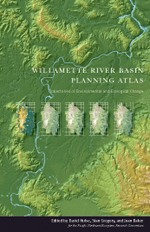
Willamette River Basin Planning Atlas
Stan Gregory, Joan Baker, and David Hulse
For The Pacific Northwest Ecosytem Research Consortium.
This title is out of print. You can access content online here.
Oregon's Willamette River Basin, which encompasses some of the nation's richest farm and forest land, is also home to most of Oregon's citizens. More than 2 million people live in the Willamette Basin today, and that number is expected to reach nearly 4 million by the year 2050.
The Willamette River Basin Planning Atlas offers a valuable resource for anyone interested in the region's past, present, and future. Using a dazzling variety of color maps, charts, and photographs, the Atlas presents a vast amount of information intended to provide a long-term, large-scale view of changes in human and natural systems within the basin.
5 chapters provide information on current conditions and historical changes since 1850, focusing in turn on land forms and geology, water resources, plants and animals, land use, and human population.
Next, there is a detailed examination of how the basin may change between now and 2050 under 3 alternative scenarios for future land and water use: one assuming a continuation of current land use and management policies, the second assuming a loosening of current policies to allow freer development, and the third assuming greater emphasis on ecosystem protection and restoration.
The final chapter demonstrates how the information and analyses presented in the Atlas can be used to prioritize and design river restoration strategies. Although the focus is on the Willamette River and its floodplain, the book's approach provides a useful model that can be applied to other regions as well.
Intended for general readers and specialists alike, the Atlas provides information to help local citizens, policymakers, and scientists make better decisions about the Willamette River Basin and its future.
About the author
Stan Gregory is professor of fisheries at Oregon State University.
Read more about this author
Joan Baker is a Research Ecologist for the US Environmental Protection Agency.
Read more about this author
David Hulse is Philip H. Knight Professor and former Chair in Landscape Architecture at the University of Oregon and a founding member of the University's Institute for a Sustainable Environment
Read more about this author
Preface
List of Maps
List of Figures
List of Tables
List of Acronyms
1. Introduction
- Study Area
- Research Program and Context
2. Landforms
- Geology
- Soils
- Elevation and Elevation Profiles
3. Water Resources
- Stream Network
- Historical Willamette River Channel Change
- Off-channel Habitats
- Flood Inundation / FEMA Floodplains
- Dams
- Revetments
- Water Sources and Allocation
4. Biotic Systems
- Presettlement Vegetation ca. 1851
- Riparian Vegetation
- Fish Assemblages
- Terrestrial Wildlife
- Environmental Frameworks
5. Human Population
- 1850 Population
- 1930 and 1970 Population
- 1990 Population Density
- 1990 Northern Valley Density
- 1990 Central Valley Density
- 1990 Southern Valley Density
- Population Pyramids
6. Land Use and Land Cover
- Transportation
- General Land Use Zoning
- Land Ownership
- Land Use / Land Cover ca. 1990
7. Trajectories of Change
- Scenario Development
- Plan Trend 2050
- Development 2050
- Conservation 2050
- Pre-EuroAmerican Scenario
- Scenario Comparisons
- Natural Vegetation
- Riparian Areas
- Agricultural Land Use
- Forestry Land Use
- Urban Land Use
- Rural Residential Land Use
- Projected Ecosystem Change
- Mainstem River
- Water Availability
- Aquatic Life
- Terrestrial Wildlife - Habitat and Biodiversity
- Terrestrial Wildlife - Populations
- Conclusions and Recommendations
8. River Restoration
- Conceptual and Spatial Framework
- Longitudinal Patterns - Channel
- Longitudinal Patterns - Floodplain Vegetation
- Longitudinal Patterns - Revetments
- Longitudinal Patterns - Human Systems
- Longitudinal Patterns - Economic Considerations
- Priorities for Restoration
- Reach and Focal Area Example
9. Bibliography
10. Appendices
- USGS Topographic Maps
- Uncertainty and Error
- Geology
- List of Terrestrial Vertebrate Species
- Presettlement Vegetation ca. 1851
- Cross-referencing Land Cover Classes between Scenarios
- River Channels 1850 - 1995
Index




